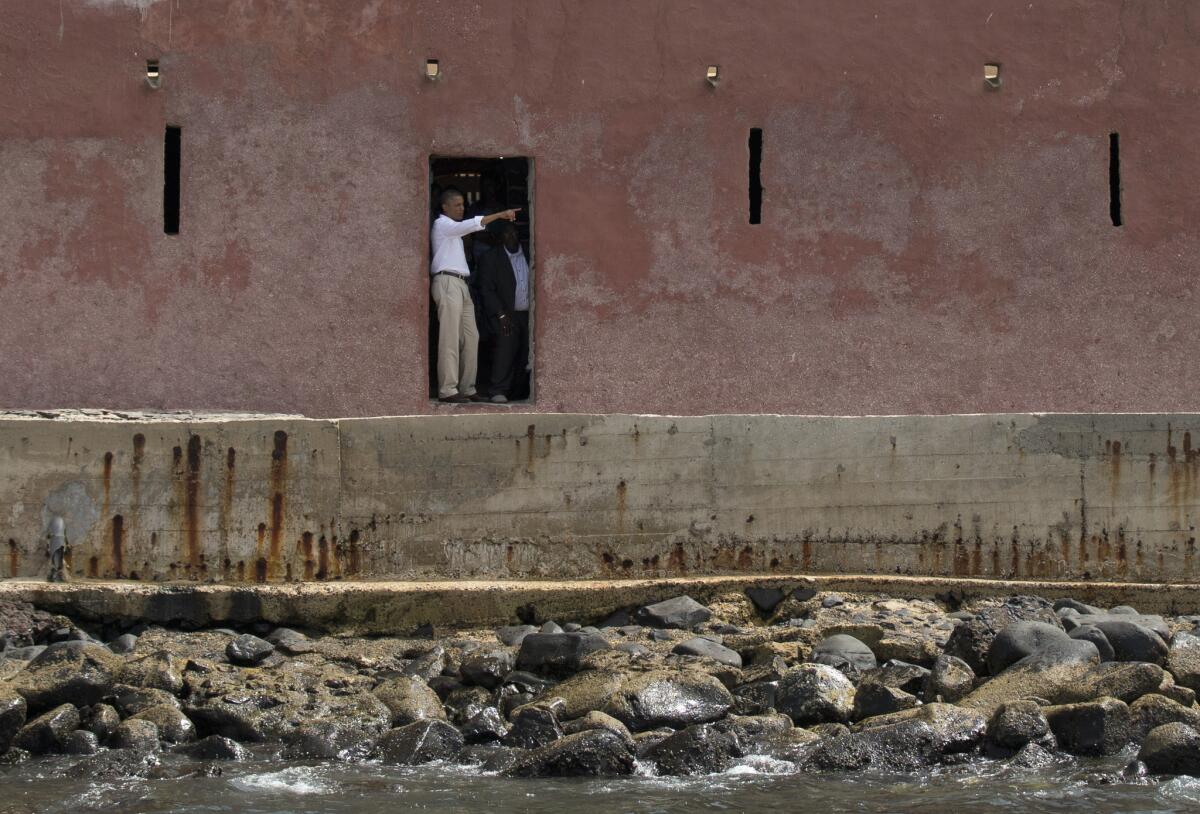President Obama calls slave site in Senegal ‘powerful’

- Share via
GOREE ISLAND, Senegal – President Obama stared pensively out the “door of no return,” described in Senegal as the last exit for those boarding ships bound for the Americas, in a house where children, women and men were separated and shackled on their way to slavery.
Obama, whose father was Kenyan and whose Kansan mother is believed to have had at least one slave among her ancestors, spent about a half hour in the two-story salmon-colored house filled with cramped cells that held slaves before their passage to America.
“Obviously for an African American, and an African American president to be able to visit this site I think gives me even greater motivation in terms of the defense of human rights around the world,” Obama said in brief comments after his tour.
“I think more than anything what it reminds us of is that we have to remain vigilant when it comes to the defense of people’s human rights – because I’m a firm believer that humanity is fundamentally good, but it’s only good when good people stand up for what’s right,” he said.
Obama was accompanied by First Lady Michelle Obama, whose great-great-grandfather was freed from a South Carolina plantation, his mother-in-law, Marian Robinson, and his daughter Malia.
“Obviously, it’s a very powerful moment whenever I can travel with my family,” the president said, “but especially for Michelle and Malia and my mother-in-law to be able to come here and to fully appreciate the magnitude of the slave trade, to get a sense in a very intimate way of the incredible inhumanity and hardship that people faced before they made the Middle Passage and that crossing.”
The president, who typically travels by motorcade or helicopter, motored out to the island in a “floatercade” of six vessels, including a blue-and-white launch festooned with Senegal’s flag and a “Welcome President Obama” banner that transported him.
Drummers, some wearing T-shirts with Obama’s likeness on them, greeted the president coming and going, while a crowd stood behind a barricade and cheered. After the tour, the president crossed over a rope line, shook hands and posed for pictures. Then he walked up behind the drummers, grooving just a little to the rhythm.
The slave house on Goree Island is a frequent destination for celebrities and world leaders wanting to acknowledge the horrors of the international slave trade. The walls of the small, crowded gift shop are covered with faded images and yellowing newspaper clippings of past visitors: Presidents Bill Clinton and George W. Bush, as well as former South African President Nelson Mandela and entertainers Harry Belafonte and Stevie Wonder.
Historians have debated whether the slave house at Goree Island was actually a major slave trading post. Recent research suggested the dusty island was largely a shipping stop, and the slave house, built in 1776 by the Dutch, may have primarily served as a merchant’s home.
Still, the symbolic significance remains a powerful draw. For the equivalent of a dollar, Goree Island tour guides tell stories of slaves to visitors, describing the moment Africans may have passed through the door for the last time before, as one put it, “Bye-bye Africa.”
Eloi Coly, the curator of the slave house who led the president’s tour, said the weight of that moment hits visitors of all races.
“It is impossible not to feel – it is a question of being a human being,” Coly said. “It is very difficult for everybody. No matter the position of who is visiting the slave house.”
ALSO:
Edward Snowden: Not the first to be caught in airport limbo
In Africa, Obama reflects on Nelson Mandela’s role in his life
Nelson Mandela ‘still there,’ responding to family, daughter says
[email protected]
Twitter: @khennessey
More to Read
Sign up for Essential California
The most important California stories and recommendations in your inbox every morning.
You may occasionally receive promotional content from the Los Angeles Times.










